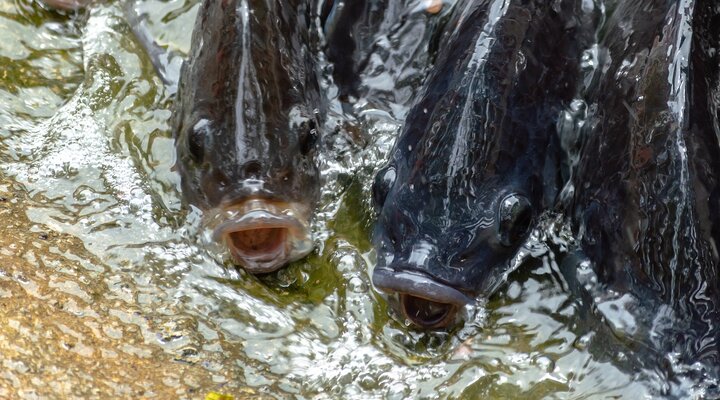Development of a nanoparticle Tilapia Lake Virus (TiLV) vaccine for tilapia aquaculture in India
Project summary
Aquaculture is the fastest growing food-production sector globally, with over 1 billion people relying on fish as their major protein source. Tilapia (Oreochromis sp.) is a major trade commodity for many low to middle-income countries (LMIC), with its production estimated to be around 6.4 million tons per annum (FAO, 2017). The hardiness of tilapia, its adaptability to various production systems and its rapid growth, makes it an excellent fish species for aquaculture. Intensification of tilapia farming has promoted severe disease outbreaks, however, resulting in high mortalities and economic hardship for tilapia farmers. Tilapia Lake Virus (TiLV), a highly virulent and contagious novel orthomyxo-like virus has recently been associated with disease outbreaks in tilapia aquaculture, resulting in massive mortalities in both wild and cultured tilapines. First reported in Israel in late 2009, TiLV-related disease outbreaks have now been reported across Asia, Africa, and North and South America. In Indian tilapia aquaculture, the virus is associated with mortality levels around 80-90%. Vaccination has proven a successful tool for controlling viral diseases in aquaculture, with most vaccines delivered by intraperitoneal (IP) injection. Many tilapia farmers will not vaccinate by injection once the fish have been moved onto the farm and would prefer fish to be vaccinated in the hatchery. It is difficult to inject small fish, however. Also TiLV tends to affect small fingerlings, some of which are too small to inject. Alternative vaccine delivery methods, such as oral or immersion delivery, are therefore needed. We will investigate a novel and innovative nanoparticle for delivery of the TiLV vaccine, comparing its efficacy when delivered by immersion, orally or by IP injection. Ultimately we aim to develop a cost-effective, easily administered vaccine for use in a large scale tilapia-production both for use in India and globally.
Project outcomes
Aquaculture has become a significant component of worldwide food production which has been bolstered by technical advancements and intensification. Oreochromis niloticus (Nile tilapia) dominates the global tilapia production providing an important source of animal protein and thus is a backbone of the tilapia aquaculture economy. Tilapia aquaculture provides essential revenue for many low-income families and is a major trade commodity for many low to middle-income countries (LMIC). However, intensification of tilapia aquaculture result in infectious diseases followed by high mortality. This results in significant production loss to tilapia farmers in the aquaculture industry and therefore new preventative methods are required to limit disease. Vaccination strategies have proven effective in protecting aquaculture from infectious diseases. Intraperitoneal (IP) injection has been the most conventional route of vaccine delivery despite being associated with exerting stress on the fish and intensive handling. Alternative vaccine delivery methods, such as oral or immersion delivery, help to overcome these stresses and are considered safer and more practical vaccine delivery methods. Vaccine technology developments like the development of nanovaccines extend the credibility of disease management towards sustainable aquaculture. Aeromonas hydrophila infection in tilapia has emerged as one of the most important bacterial diseases for farmed tilapia, for which there is no commercial vaccine. The present study aims to validate the effectiveness of a novel nanovaccine in Nile tilapia against A. hydrophila through ip, immersion and oral delivery platform and to confer protection in fish against bacterial infection. However, the safety and efficacy of the vaccine with potential delivery methods are yet to be studied. Our study will investigate a novel vaccine for A. hydrophila infection in tilapia based on an innovative nanotechnology platform, with the potential to offer effective mucosal immunostimulation using characterised cobalt oxide nanoparticles (CoNPs) coupled the antigen. The biophysical characterization of the CoNPs coupled with formalin-killed A. hydrophila vaccine was analysed by transmission electron microscopy (TEM). The nanovaccine was administered to fish via injection, immersion and oral (through feed for 7 days) delivery systems followed by a booster dose on Day 22 through the same route of delivery. A formalin-inactivated, adjuvanted A. hydrophila vaccine was used as a positive control. A virulent strain of bacteria was used to infect the vaccinated fish by IP injection, and the onset of disease was monitored for 3 weeks. The fishes were sampled at fixed time intervals for ELISA (to measure the IgM antibody titres), histopathological, immunohistochemistry and immune gene expression (RT-qPCR) analysis. A significant (P<0.05) increase in immune parameters was observed in the head kidney of vaccinated fish. Histopathological examinations showed infiltration of lymphocytes, which is thought to be elicited by the mucosal immune response to the vaccine. The relative percentage survival was measured by challenging vaccinated and non-vaccinated fishes with a virulent strain of A. hydrophila. No mortalities were observed in the vaccinated fish until the end of the experiment, which provides new insights into the safety and efficacy of the nanovaccine. The study emphasizes the success of a putative vaccination strategy, employing a novel nanovaccine, which is able to protect fish from infectious bacterial diseases. This has the potential for commercialization, highlighting the possibility of mass vaccination via practical delivery methods for sustainable tilapia aquaculture especially in LMICs.

